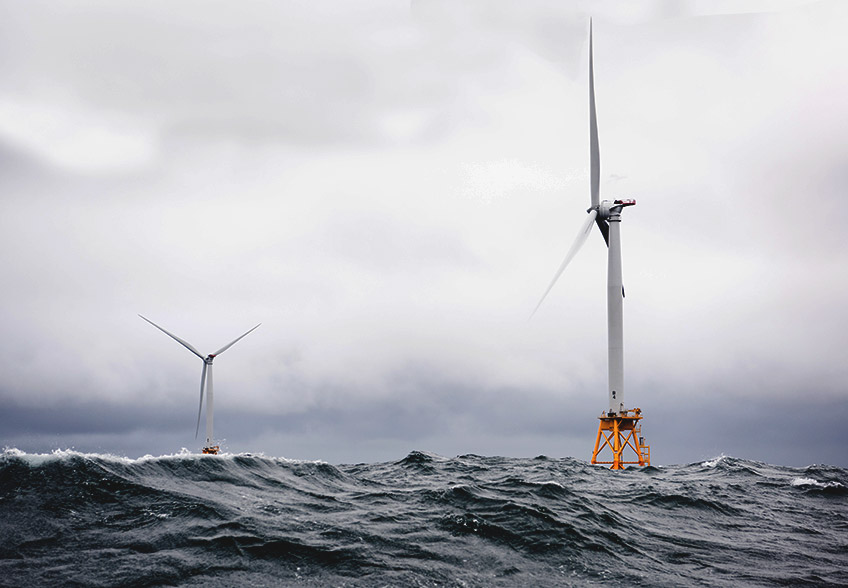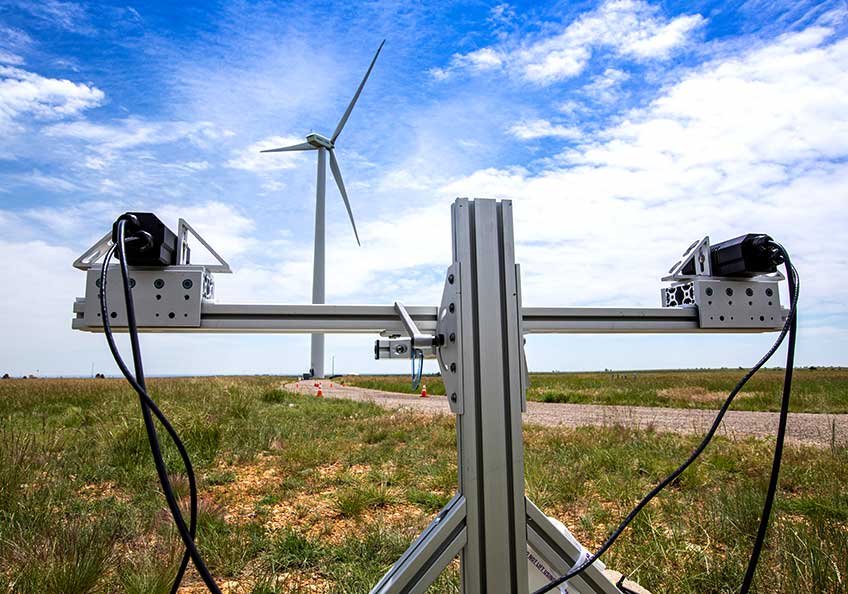The Leading Edge: September 2019 Wind Energy Newsletter
In this issue, NREL researchers detail offshore wind market status, field trials validate wake steering impacts at scale, and lab partnerships advance wind-wildlife minimization technologies.
News Stories

Offshore Wind Market Projections Indicate Accelerated Growth over Next Decade
Offshore wind market growth predictions show accelerated growth in the next decade, with global cumulative capacity ranging from 154 to 193 gigawatts (GW) by 2030, and long-range predictions of over 500 GW by 2050, according to a recent report.
Released alongside two other U.S. wind technologies market reports, the "2018 Offshore Wind Technologies Market Report" covers the status of 176 operating offshore wind projects through Dec. 31, 2018. The report, provided by the U.S. Department of Energy's (DOE) Wind Energy Technologies Office, also includes analysis of 838 global projects in various stages of development.
Field Trials Validate Wind Turbine Wake Steering Impact at Scale
If every turn of the wheel is a revolution, then every sweep of a wind turbine blade is an opportunity. NREL researchers push forward the wheel of progress with advancements to wind-power-plant-level controls that increase energy capture. By steering individual turbine wakes away from downstream turbines, existing facilities can achieve annual energy production gains of 1%-2% depending on plant size and design, which amounts to about $1 million per year in additional profits.
Protecting Eagles with Potato Cannons
A surprising combination of sophisticated sensor technology, tennis balls, a potato gun, and a novel deterrent device could hold the answers to preventing eagles from encountering wind turbines. Oregon State University researchers visited NREL's Flatirons Campus to evaluate their detection and deterrent system, known as the Eagle Take Minimization Project, by taking aim at the 1.5-megawatt (MW) General Electric research turbine.
NREL Wind Researchers Partner with Pacific Northwest National Laboratory To Validate ThermalTracker Software and Protect Wildlife
A partnership between NREL and Pacific Northwest National Laboratory helps examine how ThermalTracker, a system that uses thermal imaging to detect the presence of birds and bats, operates in the presence of wind turbines. The field trial informs enhancements to the software that will allow for more precise identification and tracking of birds and bats.
Read more about ThermalTracker and other wildlife impact minimization efforts at NREL.

NREL Announces New Project Selection To Address Wind-Wildlife Operational Challenges
NREL has selected a new project to receive a DOE-funded Technology Development and Innovation subcontract. Recipients will work with NREL researchers to help advance early-stage wildlife monitoring and impact minimization technologies for use at wind energy facilities.
In Case You Missed It
Latest Accomplishments Report Showcases Exceptional Wind Research
NREL's wind energy program conducts a broad portfolio of research and development projects that support DOE's Wind Energy Technologies Office's mission to reduce costs and accelerate wind technology deployment. The Accomplishments and Performance Report from the third quarter of Fiscal Year 2019 showcases NREL achievements and innovations that help drive the industry forward.
Shared Mooring Lines Research Will Reduce Floating Wind Costs
The U.S. National Offshore Wind Research and Development Consortium selected NREL to carry out a project focused on reducing costs and improving the economic feasibility of floating wind technology. The Shared Mooring Systems for Deep Floating Wind Farms project will assess the potential of shared mooring lines to reduce floating wind costs by connecting adjacent turbine platforms and distributing load throughout the wind farm.
NREL Receives Funding To Support Offshore Wind Development
The New York State Energy Research and Development Authority announced the selection of five multiyear projects to further study important environmental and commercial fishing topics in support of offshore wind development. NREL, partnering with the Responsible Offshore Development Alliance, received funding to understand and develop solutions for safe and efficient access to fishing grounds, while also ensuring that offshore energy projects meet their operational goals.
DOE Releases Annual Wind Market Reports
DOE released annual market reports documenting data and trends in wind installations, technologies, costs, prices, and performance through the end of 2018 for three sectors: utility-scale land-based, offshore, and distributed wind.
Recent Wind Publications
Benchmarks for Model Validation Based on Lidar Wake Measurements
In a new journal article, NREL researchers collaborate with Sandia National Laboratories to provide benchmarks that can help minimize uncertainty in wind industry model validation practices.
Three benchmarks are defined in the study with increasing levels of complexity: near neutral, slightly unstable, and very stable atmospheric stratification. The article describes the measurements and methodology used to define these benchmarks and provides the information required to perform simulations and conduct the model-measurement comparison.
Effects of Inflow Spatiotemporal Discretization on Wake Meandering and Turbine Structural Response Using FAST.Farm
FAST.Farm is a multiphysics, midfidelity engineering tool that can be used to predict turbine power and structural loads of wind turbines in a wind farm. A new journal article studies the effects of varying spatial and temporal domains on wake meandering, turbine structural response, and resulting wake and load calculations. By doing this, researchers aim to establish convergence criteria and recommendations for discretization values in terms of rotor diameter that will maximize computational efficiency of wind turbine software.
Large-Eddy Simulations of Floating Offshore Wind Turbine Wakes with Coupled Platform Motion
Better understanding of wake effects for floating offshore wind turbines is necessary to fully realize the potential of large farms of these devices. Floating platforms experience an increased range of motion that can influence wake characteristics and affect downstream turbines. A recent journal article demonstrates how researchers use large-eddy simulations to study downstream wake characteristics in a variety of meteorological ocean conditions using Simulator fOr Wind Farm Applications (SOWFA) and OpenFAST software. The study finds that observed wake differences between fixed and floating platforms are small, particularly for higher wind speeds and lower wave heights.
Understanding the Role of Short-Term Energy Storage and Large Motor Loads for Active Power Controls by Wind Power
NREL researchers contributed to a study published by DOE's Grid Modernization Laboratory Consortium validates advanced controls for active power from wind generation, short-term energy storage, and large industrial motor drives for various types of ancillary grid services. Simulations and field tests using wind turbines with a 1-MW/1-megawatt-hour battery energy storage system, variable-frequency motor drives, and photovoltaic array coupled with advanced controls showed that wind power inertial and primary responses and automatic generation control participation can be significantly enhanced with the assistance of these advanced control technologies.
Share

